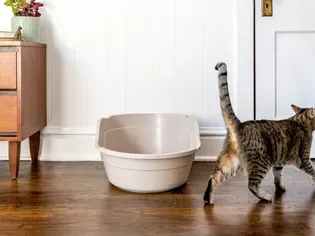How to Stop Your Cat From Tracking Litter and Poop
Updated on 04/26/24

How to Stop Your Cat From Tracking Litter and Poop: A Comprehensive Guide
Your beloved feline companion brings joy to your life, but their litter box habits can be less than desirable. Scattered litter and unsightly poop tracks leave your home looking unkempt and can pose hygiene concerns. Don't despair! With the right strategies, you can effectively put an end to these unwanted messes.
Understanding the Reasons Behind Tracking
Before delving into solutions, it's crucial to understand why cats tend to track litter and poop:
* Shallow Litter Box: A box that's too shallow allows litter and waste to easily spill over.
* Unclean Litter Box: A dirty litter box discourages cats from using it properly, leading them to eliminate elsewhere.
* Litter Type: Some cats may be sensitive to certain types of litter, causing them to scratch and scatter.
* Medical Issues: Underlying health conditions, such as urinary tract infections or arthritis, can affect a cat's litter box habits.
* Stress or Anxiety: Stressful situations or environmental changes can cause cats to behave abnormally, including tracking litter and poop.
Preventing Litter Tracking
1. Choose an Appropriate Litter Box: Opt for a deep, spacious box that allows your cat to dig and bury their waste without spilling.
2. Provide Multiple Litter Boxes: Cats prefer having multiple options, so place litter boxes in various locations throughout your home.
3. Use a High-Quality Litter: Experiment with different types of litter until you find one that your cat likes and doesn't track excessively.
4. Cover the Litter Box: A covered box gives your cat added privacy and helps prevent litter from getting scattered.
5. Place a Rug or Mat Beneath the Litter Box: A rubber or silicone mat with raised edges catches any stray litter or poop before it reaches your floors.
Preventing Poop Tracking
1. Monitor Your Cat's Elimination Habits: Observe when and where your cat eliminates to identify any potential issues.
2. Rule Out Medical Conditions: If you notice any changes in your cat's litter box behavior, consult with your veterinarian to rule out any underlying medical conditions.
3. Use a Litter Additive: Certain litter additives, such as baking soda or enzyme cleaners, help eliminate odors and discourage cats from tracking poop.
4. Provide a Designated Toilet Area: Train your cat to use a specific spot on the floor or on a special mat by placing a small amount of litter or their used litter in the desired location.
5. Remove Poop Promptly: Scoop and dispose of any poop immediately to prevent your cat from stepping in it and tracking it elsewhere.
Additional Tips
* Regularly Clean Litter Boxes: Scoop out solid waste and change the entire litter once a week to keep it fresh and inviting.
* Use a Vacuum Cleaner with a HEPA Filter: This helps remove any lingering litter or poop particles.
* Wipe Down Surfaces: Regularly wipe down surfaces around the litter box with a disinfectant to prevent odors and bacteria from spreading.
* Encourage Your Cat to Groom: Brushing or combing your cat helps remove any litter or poop particles that may have gotten stuck in their fur.
* Be Patient and Consistent: Training your cat to stop tracking litter and poop takes time and patience. Stay consistent with your efforts, and eventually, your furry friend will learn to use the litter box properly.
Conclusion
By implementing these strategies, you can effectively prevent your cat from tracking litter and poop, creating a cleaner, more enjoyable home for both of you. Remember to be patient, observant, and consult with your veterinarian if you encounter any difficulties. With a little effort, you can enjoy a harmonious coexistence with your beloved feline companion while maintaining a pristine living environment.
Explore More Pets

Cat Behavior Problems
How to Stop Aggression in Kittens

Long-Haired Cat Breeds
Siberian Cat: Breed Profile, Characteristics, & Care

Cat Behavior Problems
How to Stop Kittens From Scratching and Biting

Long-Haired Cat Breeds
Turkish Angora: Cat Breed Profile, Characteristics & Care

Basic Training
How to Socialize Your Kitten

Short-Haired Cat Breeds
Cute Pictures & Facts About Calico Cats & Kittens

Litter Box Training
Training Your Kitten to Use the Litter Box

Long-Haired Cat Breeds
10 Fun Facts About White Cats